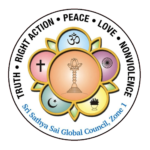
Sri Sathya Sai Speaks
Divine Discourses spanning 7 Decades (1950 – 2011)
Prasnothara Vahini (Download)
| |
The Body And Senses
Q. Why is this human body called pancha-bhauthikam
A. Because it is a product of the five basic elements (pancha-bhuuthas).
Q. What exactly are the five elements
A. Ether, air, fire, water, and earth (akasa, vayu, agni, jala, and prithvi).
Q. From where did these originate
A. Each subsequent element originated from the previous one.
Q. What is the cause of the first and therefore of all five
A. Brahman, the Supreme, the Unmodified, the Fixed, the total Basis.
Q. What is the relationship between these five elements and this human body
A. From Brahman originated all universal cosmic principles; from these was born ether; from ether, air; from air, fire; from fire, water; and from water, earth. The human body is the result of the combination of all five.
Q. In what form do these basic elements persist in the body
A. Each element has again become fivefold and has gone into the composition of the body.
Q. What five has the first, ether, become
A. The cogniser, mind, intellect, ego, and subconscious mind (jnatha, manas, buddhi, ahamkara, chittha).
Q. Speaking of “in the body”, how are these indicated
A. They are recognised as the “inner senses”.
Q. Now, what are the five forms of the next element, air (vayu)
A. Digestive, circulating, upward-moving, life breath, and downward-moving (samana, vyana, udana, prana, apana).
Q. And in the body, what are they called
A. The five vital airs.
Q. And the fire element (agni) A. That element became the sensory organs: the ear, skin, eye, tongue, and nose. Q. And how are they demarcated A. As the organs of knowledge (jnanendriyas). Q. Tell me, what five did the water element become A. Sound, touch, form, taste, and smell. Q. Do they also have a special name A. They are known as the five subtle or rudimentary elements (thanmathras). Q. The earth element remains out of the five. How does it appear in the body A. The vocal organs, hands, legs, genitals, and the excretory organs. Q. And they are known as A. As the organs of action (karmendriyas). Q. Instead of considering this human body as constituted in this manner by the elements as a single unit, the vedanthins say there are many units in it! Is that true A. There are not many, but three. Some say there are four! Q. Oh! What are they What are they called The third and the fourth A.The gross body, the subtle body, and the causal body (sthula, sukshma, and karana deha). Some aver that there is a fourth, called the super-causal body (maha-karana deha). Q. What exactly is meant by the gross body A. It means the body that is constituted of the 25 elemental principles, which I already mentioned. Q. What then is the subtle body A. The five organs of perception (jnanendriyas), the five subtlenesses (than-mathras), the five airs (pranas), the mind (manas), and the intellect (buddhi) – these seventeen categories combine to constitute the subtle body. Q. Is this called only the subtle body (sukshma deha), or does it have any other appellation A. Why shouldn’t it It has. It is also known as the light body (taijasa). Q. Is it indicated as belonging to any state A. Yes, it is. Q. And what is the name of that A. The dream state (swapna avastha). Q. Do you mean to say that the gross body has no state assigned to it A. Of course it has. Q. Tell me the name of that state. A. That is the wakeful (jagrath) state. Q. What is the causal (karana) body A. There, the subconscious mind (chittha) is in association with the knower, the knowing principle (the jnatha). Q. What is it known as A. The conscious inner individual Self. Q. And the state A. The state is deep sleep (sushupti). Q. Tell me also what they mean by the super-causal or transcendental body, the fourth. A. The pure consciousness unmixed with any or elemental principle (thathwa), the witness eternal, the Self luminous. They refer to it as the Supreme Cause. Q. Has it a name, like the rest A. It is known as Cosmic Intelligence (Hiranyagarbha). Q. And the state A. It is stateless. It is beyond all states of consciousness, so it is described as the Imperishable (Akshara-purusha). Q. Coming back to this gross body, what specific products are attributable to the five elements that united to form it A. To the earth: bone, skin, flesh, veins, hair. Q. Of water A. Blood, urine, saliva, phlegm, brain. Q. From fire A. Hunger, thirst, sleep, steadiness, mating. Q. The element air produces A. Activity, movement, speed, shame, fear. Q. Similarly, the element ether in the body must be responsible for some consequences. A. Yes, for lust, anger, greed, pride, and envy. Q. People have many addictions, don’t they Do these consequences of their composition have anything to do with their travails A. You seem to have some doubts. The reason for all the agony is this group of gross qualities. The addictions are also not many, although they may appear so. There are only four types. They are called mental inclinations (vasanas). Q. What are the four habitual inclinations A. The body, mind, wealth, and sex; though there are others, all are ultimately based on these. Q. People, in their pride, strut about blindly; what is this egotism that prods them on How many varieties of egotism are there A. There are four types: vanity of clan, vanity of wealth, vanity of youth, and vanity of scholarship. Though there are other types, they can be grouped under these.
